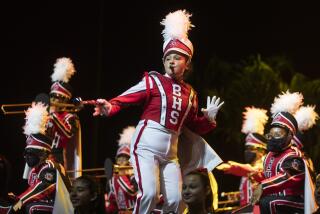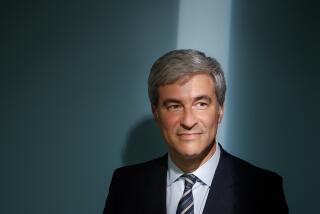NEA CHAIR RETESTING ARTS GROUPS
ST. PAUL, Minn. — Occasionally, the partnership between the National Endowment for the Arts and the National Assembly of State Arts Agencies is somewhat shaky, indicated the NEA chairman to delegates from the states gathered here.
Frank Hodsoll didn’t say so in so many words: He merely fluttered his right hand. But he added, “If it isn’t like this, it’s a dead partnership.”
That partnership--mandated by law to the extent that 20% of endowment funding must go to state arts agencies through block grants--is being tested anew this year with Hodsoll’s proposals for Challenge III, or the third version of the 9-year-old challenge-grant program.
Last year arts education was the divisive issue between the endowment and the assembly. That issue has now been resolved through a program accommodating both. This year the issue is challenge grants.
Under the new proposals, which would go into effect next October, state and local arts agencies could, for the first time, effectively qualify for these big-buck grants, which range up to $1 million.
However, the agencies worry that the required three-to-one match would bar them from competing. Moreover, as public agencies, they may not be able to pry that kind of money from state legislatures and local supervisors or councils.
Instead of funding institutions (usually the more prominent arts organizations) Challenge III, which must be approved by the National Council on the Arts, would fund projects. “We are proposing four categories--or rubrics--to support exemplary projects that have the potential to enhance artistry, access, appreciation and/or nonfederal support mechanisms,” Hodsoll told his breakfast audience of 400.
Then as he appeared to offer a little loophole to the agencies, Jonathan Katz, executive director of the arts agency assembly, looked up suddenly.
“The traditional three-to-one matching requirement of Challenge will be maintained, and will apply to our public partners as well as to other applicants”--and Hodsoll paused, “ generally .
“While there may be exceptions from time to time,” Hodsoll continued, “the burden of proof will be on the applicant to show that what it proposes to do will be sufficiently out of the normal realm of funding possibilities to warrant a different match. In other words we would require a three-to-one match in new monies--public or private, depending on the applicant--but we would not rule out the possibility that there might be very occasional exceptions.
“The reason for insisting upon the three-to-one match,” Hodsoll said, “is to assure that there are sufficient nonfederal funds available to see the project or program through,” he said.
Arts agency leaders appeared to take a bit of hope from Hodsoll’s speech. Robin Tryloff, board chairman of the assembly and executive director of the Nebraska Arts Council said, “We’re glad to see at least we got what looks like a loophole.”
At the same time, Tryloff cautioned that she wanted to “wait and see” the guidelines Hodsoll will present in November to the national council, the 26-member presidentially appointed body that Hodsoll chairs.
The caution may have been well-taken. In an interview afterward, Hodsoll appeared to take a harder line. It would be “very rare,” he said, that there would be exceptions to the three-to-one matching rule. And he insisted that the arts agencies could qualify only through public funding, because he doesn’t want them “competing with” the projects of private arts organizations for private support.
In an aside, Hodsoll said he has been told privately that the arts endowment will be funded in fiscal 1987 at $165 million. Hodsoll said that agreement was reached in the closed House-Senate conference on appropriations for the Department of Interior and related agencies this week. In fiscal ‘86, the endowment received $165.7 million. On March 1, the funding was trimmed to $158.5 million under the 4.3% cut of the Gramm-Rudman budget-balancing law.
Hodsoll also noted that because of this time of “flat” budgets, the challenge program will generally receive $18 million-$22 million a year. Last month, $21.5 million was awarded to 63 major arts institutions across the country.
The major institutions, Hodsoll indicated, may be more opposed to Challenge III than the state agencies. Under the new program, they could qualify for challenge grants through projects, but not as institutions. “They are a little nervous,” Hodsoll acknowledged.
Under the old challenge guidelines, Hodsoll said, neither visual nor folk arts were specifically funded. “Now we wouldn’t fund a public-television station, but we would fund a (TV) series on the arts.”
In his speech, Hodsoll also made reference to the arts-education issue.
Ironically, the competition among states wishing to apply for Hodsoll’s sequential arts education of a three-tiered program is so fierce that the NEA chairman noted: “We’ll have to begin with a limited number of states and an even more limited number of school districts. We must be sure that the models we create at the outset are exemplary.”
Altogether 40 state arts agencies have indicated that they will be submitting applications under the Hodsoll-sponsored section. “We’ll have a lot of important allies in this,” he added, “including the U.S. Department of Education.”
More to Read
The biggest entertainment stories
Get our big stories about Hollywood, film, television, music, arts, culture and more right in your inbox as soon as they publish.
You may occasionally receive promotional content from the Los Angeles Times.










